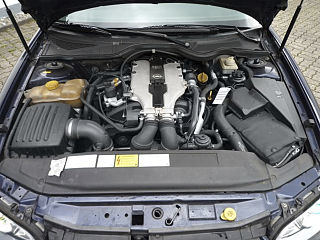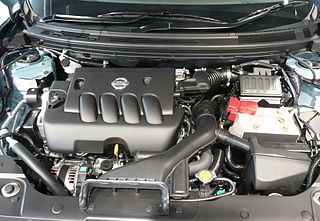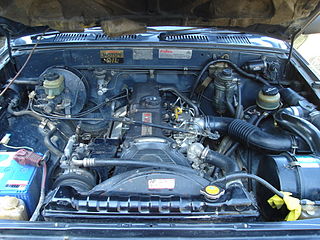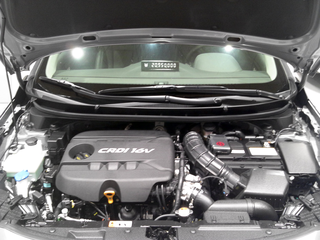Related Research Articles

The Jaguar AJ-8 is a compact DOHC V8 piston engine used in many Jaguar vehicles. It was the fourth new engine type in the history of the company. In 1997 it replaced both designs previously available on Jaguar cars: the straight-6 Jaguar AJ6 engine, and the Jaguar V12 engine. It remained the only engine type available on Jaguar until 1999 with the launch of the S-Type, when the Jaguar AJ-V6 engine was added to the list. The AJ-V8 is available in displacements ranging from 3.2L to 5.0L, and a supercharged version is also produced. Ford Motor Company also used this engine in other cars, including the Lincoln LS and the 2002-2005 Ford Thunderbird, as well as in several Land Rovers, and the Aston Martin V8 Vantage.
The Jaguar AJ-V6 engine is a specialized version of Ford's Duratec V6 engine. One notable addition is the use of variable valve timing, a feature also shared with Mazda's version of the engine. It is available in 2.1 L (2,099 cc), 2.5 L (2,495 cc) and 3.0 L (2,967 cc) displacements.

The VH series consists of 4.1 and 4.5 litres engines built from 1989 to 2001 by the Nissan Motor Corporation. The design consists of a 90-degree V8 with an aluminium cylinder block that features a closed upper deck and a deep skirt. The cylinder heads are also aluminium with a DOHC 4 valves design and pentroof combustion chambers. The production blocks and production head castings were used successfully in various forms of racing including the IRL.

The VQ is a V6 piston engine produced by Nissan with displacements varying from 2.0 L to 4.0 L. It is an aluminum block DOHC 4-valve design with aluminum heads. It is fitted with Nissan's EGI/ECCS sequential multi-point fuel injection (MPFI) system. Later versions feature various implementations of variable valve timing and replace MPFI with direct fuel injection. The VQ series engine was honored by Ward's 10 Best Engines list almost every year from the list's inception. The VQ series replaced the VG series of engines.

The QG engine is a 1.3 L (1,295 cc), 1.5 L (1,497 cc), 1.6 L (1,597 cc) and 1.8 L (1,769 cc) straight-4 piston engine from Nissan. It is a lean-burn aluminum DOHC 4-valve design with variable valve timing and optional NEO Di direct injection.

The GA engine is a 1.3 to 1.6 L inline 4 piston engine from Nissan. It has a cast iron block and an aluminum head. There are SOHC & DOHC versions, 12 valve & 16 valve versions, carbureted, single-point and multi-point injected versions, and versions with variable valve timing (GA16DE). The GA was produced from August 1987 through 2013. Since 1998 it was only available from Mexico in the B13.

General Motors' Opel subsidiary in Europe designed a compact V6 engine with an unusual 54° vee angle. It was an iron block/aluminum head DOHC design with 4 valves per cylinder. All 54° engines were assembled at Ellesmere Port in England.

The E-series was a line of inline 4-cylinder automobile engines designed and built by Honda for use in their cars in the 1970s and 1980s. These engines were notable for the use of CVCC technology, introduced in the ED1 engine in the 1975 Civic, which met 1970s emissions standards without using a catalytic converter.

The Prince G-series engine was the company's only straight-four and straight-six engines which began production in 1955. A number of variations were made, with both OHV and OHC heads. A diesel four-cylinder with 1.9 L (1,862 cc) was also built, called the D-6. The G series was used in the Skyline, the Laurel, and the Gloria from the 1950s to the early 1970s.

The Honda D series inline-four cylinder engine is used in a variety of compact models, most commonly the Honda Civic, CRX, Logo, Stream, and first-generation Integra. Engine displacement ranges between 1.2 and 1.7 liters. The D Series engine is either SOHC or DOHC, and might include VTEC variable valve timing. Power ranges from 66 PS (49 kW) in the Logo to 130 PS (96 kW) in the Civic Si. D-series production commenced 1984 and ended 2005. D-series engine technology culminated with production of the D15B 3-stage VTEC (D15Z7) which was available in markets outside of the United States. Earlier versions of this engine also used a single port fuel injection system Honda called PGM-CARB, signifying the carburetor was computer controlled.

The Suzuki G engine is a series of three- and four-cylinder internal combustion engines manufactured by Suzuki Motor Corporation for various automobiles, primarily based on the GM M platform, as well as many small trucks such as the Suzuki Samurai and Suzuki Vitara and their derivatives.

The MR is a family of straight-four all-aluminium automobile engines with variable valve timing co-developed by Renault and Nissan. Renault calls it the M engine. Other noteworthy features of this engine family include acoustically equal runner lengths and a tumble control valve for the intake manifold, a "silent" timing chain, mirror finished crankshaft and camshaft journals, and offset cylinder placement in an attempt for increased efficiency.

The L family first appeared in October 1977, it is a series of inline four-cylinder diesel engines. It is the first diesel engine from Toyota to use a rubber timing belt in conjunction with a SOHC head. Engines like 2L-II and 2L-T are still in production to the present day. As of August 2020, the 5L-E engine is still used in Gibraltar in the fifth-generation Toyota HiAce, eighth-generation Toyota Hilux and second-generation Toyota Fortuner. Vehicles with the diesel engine were exclusive to Toyota Japan dealership locations called Toyota Diesel Store locations until the sales channel was disbanded in 1988.

The L-series is a compact inline-four engine created by Honda, introduced in 2001 with the Honda Fit. It has 1.2 L (1,198 cc), 1.3 L (1,318 cc) and 1.5 litres (1,497 cc) displacement variants, which utilize the names L12A, L13A and L15A. Depending on the region, these engines are sold throughout the world in the 5-door Honda Brio Fit/Jazz hatchback Honda Civic and the 4-door Fit Aria/City sedan. They are also sold in the Japanese-only Airwave wagon and Mobilio MPV.

The MA is a straight-4 SOHC 0.9 L, 1.0 L, or 1.2 L engine introduced in 1982 by Nissan, intended primarily for the K10 series Micra/March model. It shares design similarities with the older E engine, with an 8-valve hemispherical cylinder head but differs in that it uses an aluminium cylinder block. Unusually, the specified ignition timing for the MA10 running on the specified 90 RON gasoline was 2 degrees after top dead centre, reflecting a very high flame speed in the compact combustion chambers.
The Family II is a straight-4 piston engine that was originally developed by Opel in the 1970s, debuting in 1979. Available in a wide range of cubic capacities ranging from 1598 to 2405cc, it simultaneously replaced the Opel OHV, Opel CIH and Vauxhall Slant-4 engines, and was GM Europe's core powerplant design for much of the 1980s.

The Hyundai U engine is a series of three or four-cylinder diesel engines made for automotive applications by the Hyundai Kia Automotive Group. The U series of engines includes the smallest automotive diesel engines produced by Hyundai.
The E0 series is a three-cylinder gasoline engine developed and manufactured by Honda, with a total displacement of 656 cc. The engine is intended for kei car applications. The E05A and E07A were replaced by the Honda P engine.

The Opel cam-in-head engine (CIH) is a family of automobile engines built by former General Motors subsidiary Opel from 1965 until 1998. Both four- and six-cylinder inline configurations were produced. The name derives from the location of the camshaft, which was neither cam-in-block nor a true overhead camshaft. In the CIH engine the camshaft is located in the cylinder head but sits alongside the valves rather than above them. The overhead valves are actuated through very short tappets and rocker arms. The four-cylinder CIH was largely supplanted by the Family II unit as Opel/Vauxhall's core mid-size engine in the 1980s. A four-cylinder version of the CIH remained in limited production until 1998, and six-cylinder versions of the CIH until 1995.

